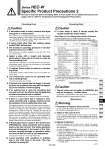
7-p1379-1411-hec_en@@@34 / 34
10bÐèBOOKäy[WèÖÛçÉñ
Communication Caution Maintenance Warning Circulating Fluid Caution 14. If clear water is used, it should satisfy the quality standards shown below. Circulating Fluid Caution Clear Water (as Circulating Water) Quality Standards Standard item Reference item Item pH (at 25C) Electrical conductivity (25C) Chloride ion (Cl.) Sulfuric acid ion (SO4 2.) Acid consumption amount (at pH4.8) Total hardness Calcium hardness (CaCO3) Ionic state silica (SiO2) Iron (Fe) Copper (Cu) Sulfide ion (S2 .) Ammonium ion (NH4 +) Residual chlorine (Cl) Free carbon (CO2) Unit . [òS/cm] [mg/L] [mg/L] [mg/L] [mg/L] [mg/L] [mg/L] [mg/L] [mg/L] [mg/L] [mg/L] [mg/L] [mg/L] Standard value Influence Corrosion Scale generation 6.0 to 8.0 100. to 300. 50 or less 50 or less 50 or less 70 or less 50 or less 30 or less 0.3 or less 0.1 or less Should not be detected. 0.1 or less 0.3 or less 4.0 or less ÞÝ ÞÝ ÞÝ ÞÝ ÞÝ ÞÝ ÞÝ ÞÝ ÞÝ ÞÝ ÞÝ ÞÝ ÞÝ ÞÝ ÞÝ ÞÝ ÞÝ Series HEC-W Specific Product Precautions 2 Be sure to read this before handling. Refer to front matter 41 for Safety Instructions and pages 1246 to 1249 for Temperature Control Equipment Precautions. 3. If deionized water is used, bacteria and algae may grow in a short period. If the Thermo-con is operated with bacteria and algae, its heat exchanging capacity or the capacity of the pump may deteriorate. Exchange all deionized water regularly depending on the conditions (once a month as a guide). 4. If using a fluid other than this catalog, please contact SMC beforehand. 5. The maximum operating pressure of circulating fluid circuit is 0.1 MPa. If this pressure is exceeded, leakage from the tank in the Thermo- con can result. 6. Select a pipe with a length and diameter which allow a flow rate of 3 L/min or more for the circulating fluid. If the flow rate is less than 3 L/min, the Thermo-con cannot provide precise control, but also can fail because of the repeated cooling and heating operation. 7. A magnet driven pump is used as a circulating pump. A fluid which contains metal powders such as iron powder cannot be used. 8. The Thermo-con must not be operated without circulating fluid. The pump can break due to idling. 9. If the tank lid is opened after the supply of circulating fluid, the circulating fluid may spill out depending on the condition of external piping. 10. If an external tank is used, the circulating fluid may spill out from the internal tank lid depending on where the external tank is installed. Check that the internal tank has no leakage if using an external tank. 11. If there is a point where fluid is released to atmosphere externally (tank or piping), minimize the piping resistance at the circulating fluid return side. If the piping resistance is too large, the piping may be crushed, or the built-in circulator tank may be deformed or cracked because the pressure in the piping for return will become negative. The built-in circulator tank is made of resin (PE). Therefore, the tank may be crushed if the pressure is negative. Special attention must be paid if the flow rate of the circulating fluid is high. To avoid getting negative pressure less than .0.02 MPa, the piping for return should be as thick and short as possible to minimize the piping resistance. It is also effective to restrict the flow rate of circulating fluid or remove the gasket of internal tank for the release to atmosphere. 12. If fluorinated fluid is used in the Thermo-con (HEC006/012), static electricity will be generated by the flow of fluid. This static electricity may be discharged to the board of the Thermo- con, causing damage or operation failure and loss of data of such as set temperature. Ground pipe in order to remove static electricity. 13. Avoid operation with cavitation or bubbles due to low fluid level in the tank. This may shorten the pump life. The Japan Refrigeration and Air Conditioning Industry Association JRA GL-02-1994 gCooling water system . Circulating type . Supply waterh 1. The set value can be written to EEPROM, but only up to approx. 1 million times. In particular, pay attention to how many of times the writing is performed using the communication function. 1. Prevention of electric shock and fire Do not operate the switch with wet hands. Also, do not operate the Thermo-con with water left on it. 2. Action in the case of error If any error such as abnormal sounds, smoke, or bad smell occurs, cut off the power at once, and stop supplying and conveying fluid. Please contact SMC or a sales distributor to repair the Thermo-con. 3. Regular inspection Check the following items at least once a month. The inspection must be done by an operator who has sufficient knowledge and experience. a) Check of displayed contents. b) Check of temperature, vibration and abnormal sounds in the body of the Thermo-con. c) Check of the voltage and current of the power supply system. d) Check for leakage and contamination of the circulating fluid and intrusion of foreign objects to it, and subsequent replacement of water. e) Check for leakage, quality change, flow rate and temperature of facility water. . In the case of [MÑÞcm], it will be 0.003 to 0.01. Þ ÞÝ: Factors that have an effect on corrosion or scale generation. Þ Even if the water quality standards are met, complete prevention of corrosion is not guaranteed. 1411 HRG HRS HRZ HRZD HRW HEC HEB HED HEA IDH